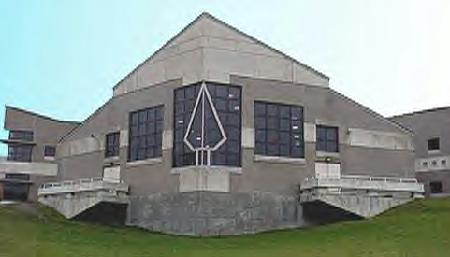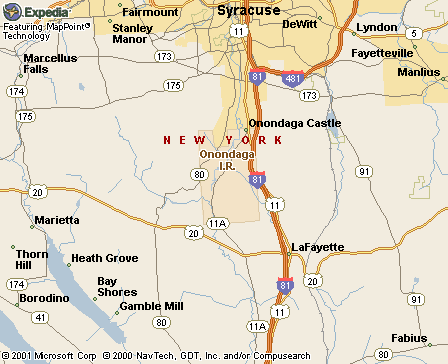|
|
Canku Ota |
|
|
(Many Paths) |
||
|
An Online Newsletter Celebrating Native America |
||
|
December 15, 2001 - Issue 51 |
||
|
|
||
|
State Test Questions Offensive to Iroquois |
||
|
by Maureen Nolan
The Syracuse Post Standard-December
8, 2001
|
||
|
photo:
Onondaga Nation School
|
|
Among them were students at the Onondaga Nation School. As they worked their way through the test, they found on a page under the heading of "ceremonial objects" images of two masks that the Iroquois hold sacred. They are definitely not meant for display, even among themselves. When Freida Jacques, Onondaga clan mother and home school liaison at the Onondaga Nation School, got a good look at the test, she found more to object to than the depiction of the sacred masks. The test talked about ceremonies that the Iroquois, who call themselves the Haudenosaunee, prefer not be discussed, she said. It referred to a war club as an object that was used in daily life. To Jacques, the test makes the Haudenosaunee sound like people who existed merely in the past. A number of other Haudenosaunee agreed with her concerns when a reporter showed them the test for the first time Wednesday. "It goes back to where we're the arrowhead culture," said Rick Hill of the Haudenosaunee Resource Center in Tonawanda and a Tuscarora. Roseanne DeFabio, state assistant commissioner for curriculum, instruction and assessment, said the state Education Department state is extremely sorry and disappointed that inappropriate material was included in the test. It was a mistake that happened despite a system to catch bias and ensure sensitivity, she said. "I'm very sorry that in any way this was offensive to them because the aim was clearly the opposite," DeFabio said. The section of the test that deals with the Haudenosaunee is known as the "document-based question" and is designed to test a student's ability to work with a historical document. One of the documents shows drawings of a toboggan, snowshoes and people crafting a canoe. Students are asked, based on the drawings, to tell three ways the Iroquois have used trees to meet their transportation needs. Another shows four objects made from shells, including a war club, and asks test-takers to pick two and explain how each was used in daily life. One of the main reasons for using the Haudenosaunee in the document-based questions on the state-required social studies test "is to stress the importance of the Native American culture to the history of New York state," DeFabio said. Document-based questions are historical in nature and don't pretend to be contemporary, she said. The state uses consultants from relevant cultural groups to review curriculum, she said. The day the material was reviewed, the Iroquois reviewer, whom she couldn't identify, was not on hand, she said. The Education Department has a Native American on staff, but he mainly looks at materials for the high school level, she said. DeFabio said she does not think he was asked to review the fifth-grade test material. The Haudenosaunee test questions were written by social studies teachers from around the state, who took the material directly from an anthology of Indians in North America, she said. Oren Lyons, an Onondaga faithkeeper, questioned why the Haudenosaunee portion of test made no mention of contemporary native life. The test reflects a "rolling back" in how the native people are represented, Lyons said. At the very least, the state should have run that section of the test past a traditional native person, Jacques said. She suggested to Sid Hill, an Onondaga and the tadadaho, or spiritual leader, of the Iroquois Confederacy, that they supply the state Education Department with a list of people they can use as resources. Hill said he wished he'd seen the test before he and other members of a committee of Haudenosaunee met with Education Commissioner Richard Mills last week. One of the issues the committee brought up was the state curriculum related to the Haudenosaunee. Hill describes it as containing misinformation. Committee members told Mills they want the state to work with them to develop a new curriculum on native people, Hill said. The social studies test will "egg us on" to make that happen, he said. Colleen Zawadzki, a staff development specialist with Onondaga-Cortland-Madison BOCES, oversaw the scoring last week of the fifth-grade tests for more than 15 local districts. About 90 teachers from those districts did the scoring. When she first saw the document-based question, Zawadzki said she was delighted, especially when she saw it used the word Haudenosaunee, which is used by the native people themselves instead of "Iroquois." "And then as I moved through the document, I thought, 'Uh-oh,' " Zawadzki said. She recognized that some of the material was inappropriate. She later spoke with the Onondaga Nation School principal and learned the test had been a concern there. Zawadzki asked Jacques to come in and explain the concerns to the teachers who would be scoring the exams. Questions are not reused on state tests, Zawadzki said. But she wanted to get the word out to teachers about the problems because teachers will be using this year's document-based questions to prepare students for next year's fifth-grade test. "And right now what we have is a flawed model out there for teachers to practice with," she said.
|
||||||||||
|
|
||
|
|
||
| Canku Ota is a free Newsletter celebrating Native America, its traditions and accomplishments . We do not provide subscriber or visitor names to anyone. Some articles presented in Canku Ota may contain copyright material. We have received appropriate permissions for republishing any articles. Material appearing here is distributed without profit or monetary gain to those who have expressed an interest. This is in accordance with Title 17 U.S.C. section 107. | ||
|
Canku Ota is a copyright © 2000, 2001, 2002 of Vicki Lockard and Paul Barry. |
||
|
|
|
|
|
The "Canku Ota - A Newsletter Celebrating Native America" web site and its design is the |
||
|
Copyright © 1999, 2000, 2001, 2002 of Paul C. Barry. |
||
|
All Rights Reserved. |
||

 A
top official in the state Education Department is apologizing for mistakenly
including inappropriate material about Iroquois culture in a portion
of the new state social studies test taken last month by about 250,000
fifth-graders.
A
top official in the state Education Department is apologizing for mistakenly
including inappropriate material about Iroquois culture in a portion
of the new state social studies test taken last month by about 250,000
fifth-graders. 